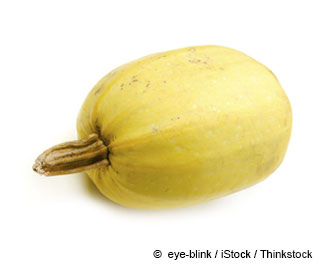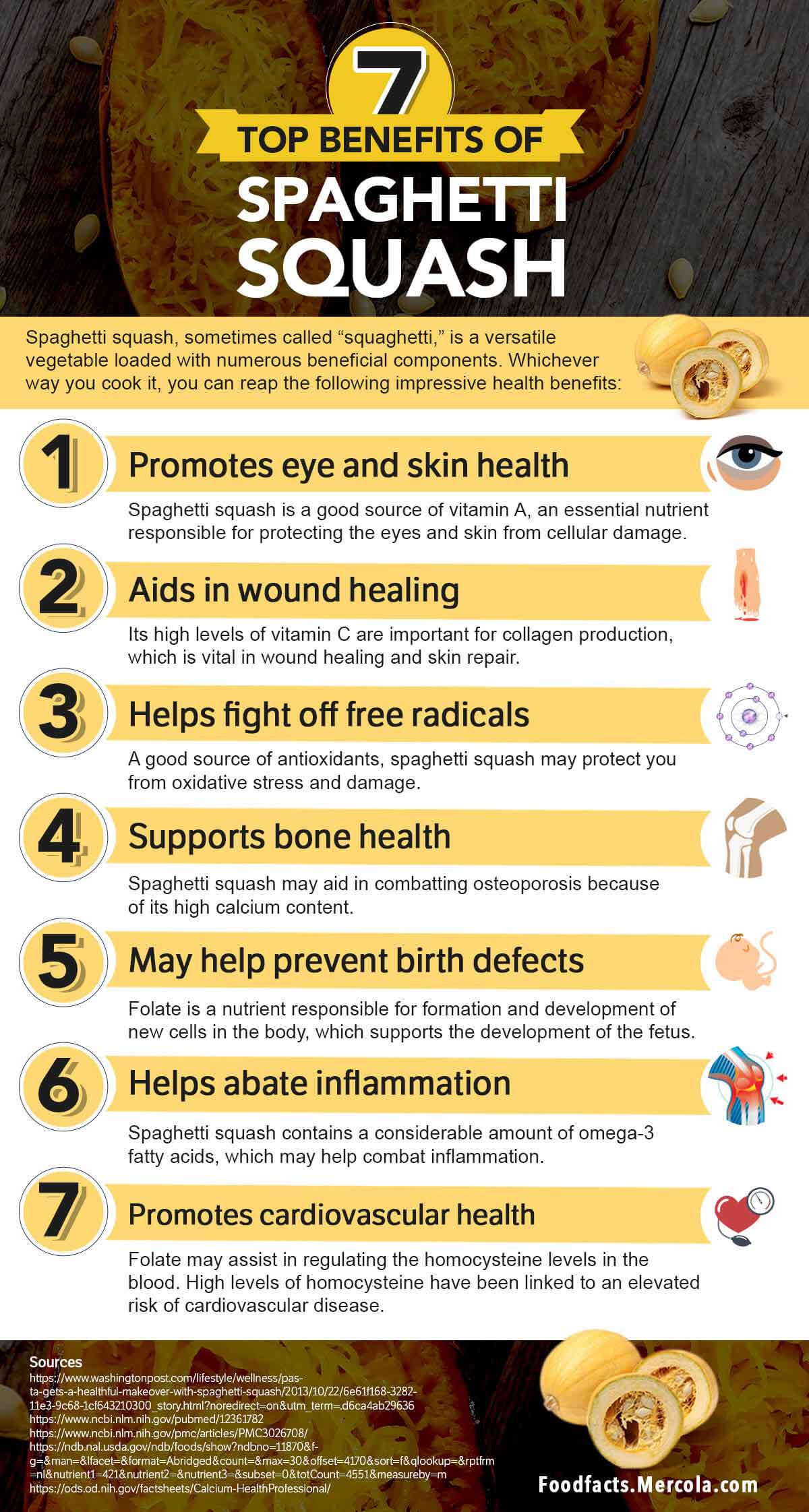The Healthy Spaghetti
Botanical name: Cucurbita pepo

Spaghetti squash is a type of winter squash that possesses an uncanny resemblance to spaghetti noodles when cooked, hence its name. It's cylindrical, measuring around 12 inches in length and 6 inches in diameter, with a weight ranging between 2 and 3 pounds.1,2,3
Although spaghetti squash may not taste exactly the same as pasta, its mild flavor and spaghetti-like texture still make it a good companion for a wide variety of flavorful sauces like marinara and curry.4 It can also be added to various dishes, such as soups and stews.
When buying spaghetti squash, choose one that has a firm rind, with no bruises or soft spots. The color of its rind may range from creamy white to pale yellow to orange, and some are patterned, too. Orange-colored squashes are the best choice, as they have higher beta-carotene content.5 You can store spaghetti squash at room temperature for up to three weeks.6
Health Benefits of Spaghetti Squash

Spaghetti squash is a good source of the B vitamins riboflavin, niacin, pyridoxine and pantothenic acid, which act as "critical cofactors for axonal transport, excitability of neurons, synthesis of neurotransmitters and numerous cellular metabolic pathways."7,8
Folate is also found in this bright-colored vegetable.9 This vitamin helps support the formation and development of new cells and may help reduce the risk for birth defects, making spaghetti squash an ideal food for pregnant women. It may also help regulate homocysteine metabolism and promote cardiovascular health.10
Potassium, a mineral that helps maintains proper muscle and nerve function, is present in spaghetti squash,11 making it beneficial for people with high blood pressure.12 Manganese, a mineral that plays a role in bone and tissue health, metabolism and immune response, is another key component in this gourd.13,14,15
Spaghetti squash contains the essential minerals calcium, iron, phosphorus and zinc. Check out the table below to learn more about its nutritional value:16
Spaghetti Squash Nutrition Facts
Serving Size: 3.5 ounces (100 grams), raw
| Calories |
31 |
|
| Total Fat |
0.57 g |
|
| Saturated Fat |
0.117 g |
|
| Trans Fat |
|
|
| Cholesterol |
0 mg |
|
| Sodium |
17 mg |
|
| Total Carbohydrates |
6.91 g |
|
| Dietary Fiber |
1.5 g |
|
| Sugar |
2.76 g |
|
| Protein |
0.64 g |
|
| Calcium 23 mg |
Iron |
0.31 mg |
Studies on Spaghetti Squash
A study published in the International Journal of Science and Research analyzed the seed extract of spaghetti squash in different solvents to determine its antimicrobial activity and found that it may help inhibit Pseudomonas aeruginosa, Proteus vulgaris, Staphylococcus aureus and E. coli bacterial strains.
Results showed that the "species, strains and concentrations of spaghetti squash extract" may influence the sensitivity of the tested pathogenic microbes. The researchers also concluded that the seed extract of spaghetti squash contains "potential antimicrobial components that may be of great use … as a therapy against various diseases."17
Spaghetti Squash Healthy Recipes:
Spaghetti Squash With Wicked Good Sauce
If you'd like to add this nutrient-filled vegetable to your diet, you'll be delighted to know that there are numerous recipes you can try out. Here are two healthy choices you and your family will love:18

|
Ingredients:
|
|
✓ 1 spaghetti squash, about 3 pounds
|
✓ 3/4 to 1 cup of Wicked Good Sauce (recipe as follows)
|
Procedure:
- Preheat oven to 350 degrees Fahrenheit. Wash the spaghetti squash then poke it with a fork or a metal skewer in about six places. Place in shallow baking pan with sides.
- Bake for 90 minutes or until fork-tender. Allow the squash to cool for about 10 minutes then transfer it to the cutting board. Cut it in half, lengthwise. Scoop out and discard seeds and pulp using a large spoon or an ice cream scoop. Using a fork, rake the flesh onto a large platter or bowl to create the spaghetti-like strands.
- Toss the squash with the Wicked Good Sauce and serve warm.
|
Wicked Good Sauce Ingredients:
|
|
✓ 1/2 cup of water (or more)
|
✓ 1 teaspoon coconut oil
|
✓ 1 clove garlic
|
✓ 1/2 teaspoon minced ginger
|
|
✓ 1/4 green bell pepper
|
✓ 1 tablespoon almond butter
|
✓ 1 tablespoon tamari soy sauce
|
✓ 1/4 medium-sized onion, chopped
|
|
✓ 2 tablespoons chopped celery leaves
|
✓ 2 tablespoons toasted pumpkin seeds
|
|
|
Procedures:
- Sauté onion in oil with the whole garlic. When the onion is tender, smash the garlic with a fork. Add the ginger and bell pepper and cook gently a minute more.
- Stir in the almond butter and tamari, and then add the water and celery leaves. Stir the mixture until smooth then simmer for about five minutes. Add the pumpkin seeds and heat through.
Note: This recipe makes four servings.
(From "Healthy Recipes for Your Nutritional Type" by Dr. Mercola)
Spaghetti Squash Aglio Olio With Rainbow Chard Recipe
|
Ingredients:
|
|
✓ 1 cup grated parmesan cheese
|
✓ 1/3 cup and 1 tablespoon coconut oil
|
✓ Himalayan salt
|
|
✓ 8 cloves garlic, thinly sliced
|
✓ Salt and pepper
|
✓ 1 bunch rainbow chard, chopped
|
|
✓ 1 large or 2 medium-sized spaghetti squash, halved and deseeded
|
✓ 1/2 to 1 teaspoon crushed red pepper flakes
|
✓ 1/2 cup fresh parsley, chopped
|
Procedure:
- Preheat oven to 400 degrees Fahrenheit.
- Drizzle 1 tablespoon of coconut oil all over the cut sides of the spaghetti squash. Sprinkle with salt and pepper.
- Place cut side up on a baking sheet. Roast for about 30 to 45 minutes, or until the squash is tender enough to scrape into strands.
- Place a large skillet over medium heat and add the remaining olive oil, garlic and crushed red pepper flakes.
- Cook the ingredients for about five to eight minutes, or until the garlic is caramelized and fragrant, stirring often.
- Stir in the chard. Season with salt and pepper.
- When the squash is done, scrape it into strands and toss in garlic oil and 1/4 cup of water.
- Add parsley and parmesan. Toss again to coat. Serve.
(Recipe adapted from Half-Baked Harvest19)
Spaghetti Squash Fun Facts
Both pasta and spaghetti squash have low amounts of fat, salt and fiber. However, pasta contains 158 calories and about 31 grams of carbohydrates for every 100-gram serving,20 which could put your health at risk if consumed excessively. In contrast, spaghetti squash has only about 31 calories at the same serving size, is rich in protein and has a lower carb content,21 making it a better option for your health.
Another way to make spaghetti-like noodles from spaghetti squash is through boiling. All you need to do is heat a pot of water large enough to hold the entire spaghetti squash. When the water is boiling, put the squash in the pot and allow it to cook until fork-tender. Once cooked, cut the squash in half and remove the seeds. Using a fork, separate the strands to achieve the same form as pasta.22